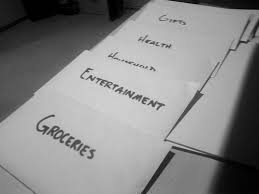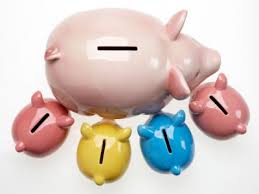Our On Track Money Management System is designed to help you do two things: a) stay on track with monthly and annual expenses; and b) save for your goals.
The system goes back to the old days of putting money into envelopes to make sure everything—from groceries to the gas bill—got paid. When payday rolled around, you’d put cash for groceries in one envelope, money for the bills in another, savings towards new clothes for school in yet another and so on.
everything—from groceries to the gas bill—got paid. When payday rolled around, you’d put cash for groceries in one envelope, money for the bills in another, savings towards new clothes for school in yet another and so on.
To implement our system we suggest opening several bank accounts. Here’s what we recommend:
- One Main Chequing Account for fixed costs and regular monthly payments
- A Monthly Spending Account for things you tend to spend money on every month
- Several Savings accounts to save up for Lump Sum and Annual Expenses
The idea is to use different bank accounts to create ‘electronic’ envelopes—so the car insurance money gets saved and not spent on pedicures, the  account for university fees adds up instead of being drained by car repairs or other unexpected expenses. And the vacation budget, often a priority but usually the first to be sacrificed to overspending in other areas, gets stashed in an account labelled ‘Travel,’ safe from impulse shoe buying or unlimited lattes.
account for university fees adds up instead of being drained by car repairs or other unexpected expenses. And the vacation budget, often a priority but usually the first to be sacrificed to overspending in other areas, gets stashed in an account labelled ‘Travel,’ safe from impulse shoe buying or unlimited lattes.
In effect, it doesn’t just give you a budget to follow, it forces you to limit your spending in each category to the amount you have in the account. If you’ve determined that it costs you $800 a month for groceries and by the third week you’re down to your last $60 in the Monthly Spending Account, no seeking solace in the credit card or pilfering other accounts. Get out the recipes and use up what’s left in the cupboard.
The payoff can be huge. And not just in terms of money, but of peace of mind.
(From UNSTUCK – How to Get out of Your Money Rut and Start Living the Life you Want by Money Coaches Canada & Women’s Financial Learning Centre co-founders Karin Mizgala and Sheila Walkington)

How do you avoid all kinds of fees for all these bank accounts?
Good question Lynn. We don’t like to pay bank fees either.
You can open a number of high interest savings accounts with no monthly fees, and to avoid any transactions costs you should only transfer money between the accounts. For instance, when you need money from your travel account just transfer it to you main account and withdrawal it from there.
And depending on where you bank you might be able to open free, or low fee chequing accounts as well.
I do this technique of “electronic envelopes” by having several designated back accounts. But here is my issue: what’s an easy way to know where I’m at with those envelopes in the day to day moment of everyday life? Like when I’m stopping off to get groceries after work, standing in line at the drug store etc? I dont know how much is left in the budget. Any suggestions on a quick and easy way to keep track?
If I know I am going shopping for a specific item, I check my balances on-line before I head out the door to shop. And I know many of my clients use an on-line application on their cell phone to check balances on the spot, but I realize not everyone is comfortable with this. Barring those two options you might have to do it the old fashioned way and work with paper and pencil. Each week print off your bank balances and put them in your wallet/purse and update as you spend.